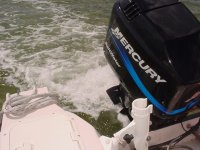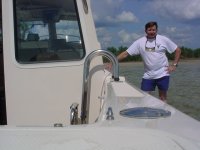Ok, like most, I have a basic understanding of horsepower, torque, RPM, and various measures of engine output. I've looked at "performance curves" and tried to divine what they're telling me...and have even done some field trials to measure peak performance and best cruise (economy) performance. That's fine, and kind of fun ... for a while. After you collect performance data then you change something (different prop, operate at a different altitude, alter the load significantly, etc.) and it all changes!
Looking at performance curve charts I suspect they're giving me some useful information, but I don't have the technical background to interpret the data. Help.
I suspect that imbedded in the charts may be some useful data regarding how we can "best" utilize our equipment, to enhance performance, economy, etc. Airplanes come with all sorts of performance data, manuals, neat-o charts, and such. Boats and outboards come with a user manual that tells us: (1) wear your PFD, and (2) don't exceed 26,000rpm with your outboard motor. Might be nice to have more engineering info - OR a rational means of developing our own data. I suspect performance charts may be somewhere to begin. (Any good websites written for non-engineers?)
Rereading this - maybe I need to get a job with Powerboat Reports. ...naw, too much like Work.
Some questions:
(1) Where on the "torque curve" is a good place to operate, for best economy? Near the leading edge of max torque? If that rpm isn't within your prefered cruising speed/rpm, could you reach-it by making prop/pitch adjustments? Good/bad idea?
(2) I know what the "sweet spot" it; but theoretically, where is that on the performance charts?
(3) What is the optimum operating rpm for a 4-stroke (or 2 stroke) motor over the long haul? During new motor break-in they tell us to vary rpm and not to use WOT for more than "short bursts" of a few minutes. Some folks have suggested that it's ok to operate for extended periods at 80% of WOT (that seems a bit hot to me, but I come from a recip aviation background where 65% is often economical-cruise).
(4) If max horsepower is developed at the top edge of engine capability; of what use is it (unless you plan to operate at/near redline a good part of the time)? (Not my plan.)
(5) How do torque and horsepower interrelate? It seems to me that torque describes an engine's ACTUAL ABILITY to perform work - whereas horsepower is more a theoretical measure of an engine's potential.
(6) When choosing a prop - it seems that choosing one with less pitch (higher rev) might be good as it would insure the engine is not lugged (pulling too much manifold pressure...). What does that do to economy? That leads to another question:
(7) Which is better for economy - operating at slightly higher rpm with less engine loading, or letting the engine "pull" more manifold pressure by using a higher pitch prop, to capture the efficiency of prop(pitch)-travel.
(8) And finally - I've always chosen the higher horsepower avenue when choosing an engine. But that may be flawed. An engine's high-end potential isn't where most work is done. All you may be doing is feeding more horses. I think I'm coming around to respecting torque over horses (that conversion has taken a Long time...). I'm sure Tybo will set me straight in his charitable-way! (Mike: Be Gentle.)
Sorry to have gone on so long - but these are things I've pondered for a while, but I just don't have the technical background to come up with definitive answers.
Guess it's time for Tyboo Mike, Learned Les, or the Dynamic Dusty, Brilliant Bill, as well as Others to wade-in. Will be interested to hear other thoughts - if anybody bothers to read this far!
Thanks,
Casey
C-Dory Naknek
...bored in Arizona
Looking at performance curve charts I suspect they're giving me some useful information, but I don't have the technical background to interpret the data. Help.
I suspect that imbedded in the charts may be some useful data regarding how we can "best" utilize our equipment, to enhance performance, economy, etc. Airplanes come with all sorts of performance data, manuals, neat-o charts, and such. Boats and outboards come with a user manual that tells us: (1) wear your PFD, and (2) don't exceed 26,000rpm with your outboard motor. Might be nice to have more engineering info - OR a rational means of developing our own data. I suspect performance charts may be somewhere to begin. (Any good websites written for non-engineers?)
Rereading this - maybe I need to get a job with Powerboat Reports. ...naw, too much like Work.
Some questions:
(1) Where on the "torque curve" is a good place to operate, for best economy? Near the leading edge of max torque? If that rpm isn't within your prefered cruising speed/rpm, could you reach-it by making prop/pitch adjustments? Good/bad idea?
(2) I know what the "sweet spot" it; but theoretically, where is that on the performance charts?
(3) What is the optimum operating rpm for a 4-stroke (or 2 stroke) motor over the long haul? During new motor break-in they tell us to vary rpm and not to use WOT for more than "short bursts" of a few minutes. Some folks have suggested that it's ok to operate for extended periods at 80% of WOT (that seems a bit hot to me, but I come from a recip aviation background where 65% is often economical-cruise).
(4) If max horsepower is developed at the top edge of engine capability; of what use is it (unless you plan to operate at/near redline a good part of the time)? (Not my plan.)
(5) How do torque and horsepower interrelate? It seems to me that torque describes an engine's ACTUAL ABILITY to perform work - whereas horsepower is more a theoretical measure of an engine's potential.
(6) When choosing a prop - it seems that choosing one with less pitch (higher rev) might be good as it would insure the engine is not lugged (pulling too much manifold pressure...). What does that do to economy? That leads to another question:
(7) Which is better for economy - operating at slightly higher rpm with less engine loading, or letting the engine "pull" more manifold pressure by using a higher pitch prop, to capture the efficiency of prop(pitch)-travel.
(8) And finally - I've always chosen the higher horsepower avenue when choosing an engine. But that may be flawed. An engine's high-end potential isn't where most work is done. All you may be doing is feeding more horses. I think I'm coming around to respecting torque over horses (that conversion has taken a Long time...). I'm sure Tybo will set me straight in his charitable-way! (Mike: Be Gentle.)
Sorry to have gone on so long - but these are things I've pondered for a while, but I just don't have the technical background to come up with definitive answers.
Guess it's time for Tyboo Mike, Learned Les, or the Dynamic Dusty, Brilliant Bill, as well as Others to wade-in. Will be interested to hear other thoughts - if anybody bothers to read this far!
Thanks,
Casey
C-Dory Naknek
...bored in Arizona


